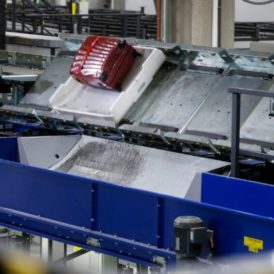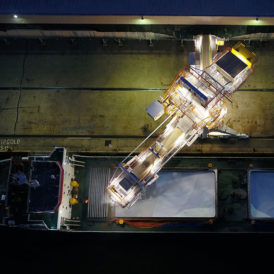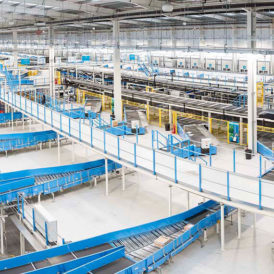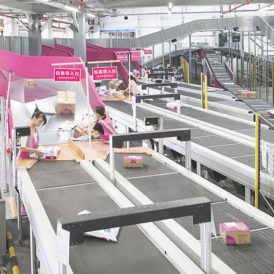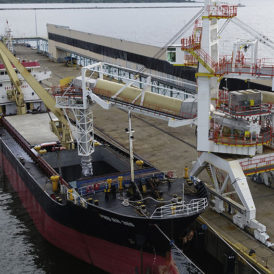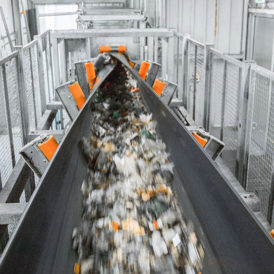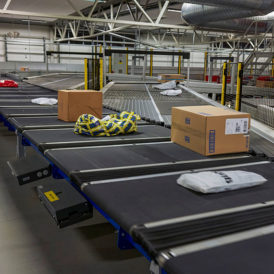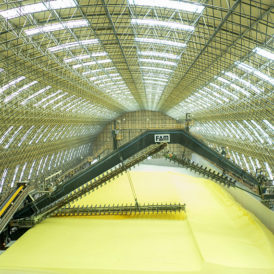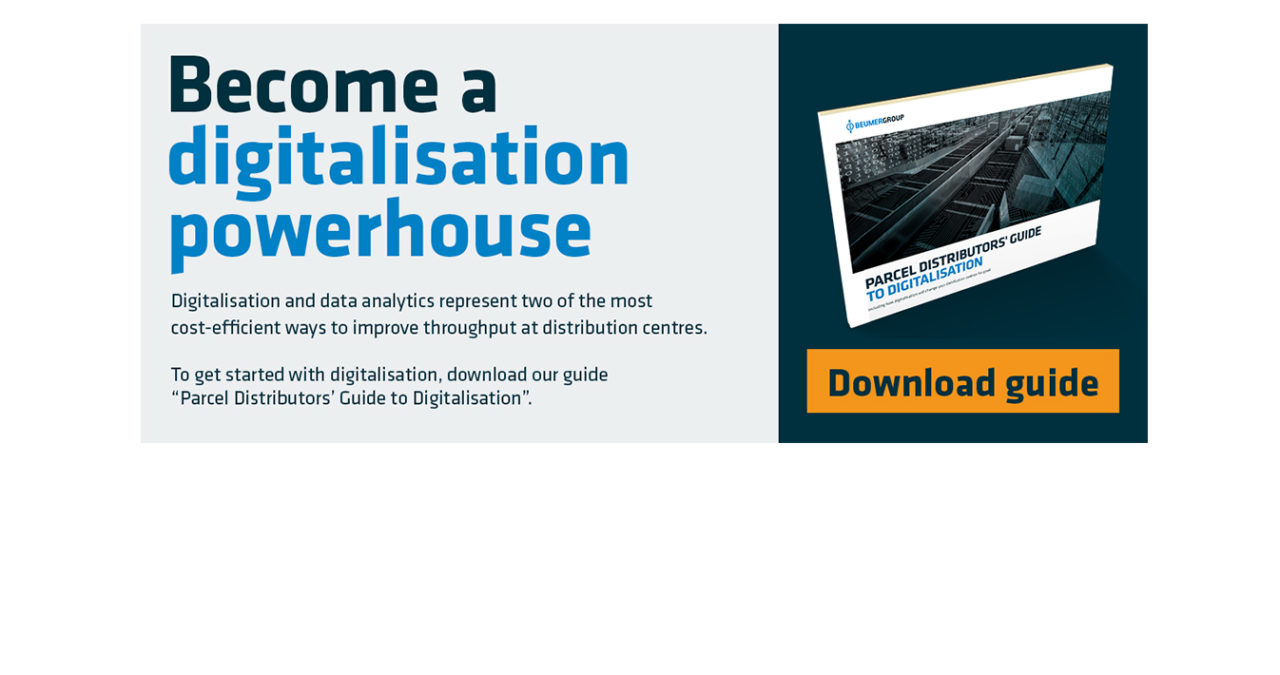By Sebastian Titze
What does digitalisation mean to the CEP industry?
For Courier, Express and Parcel (CEP) companies, digitalisation might refer to a number of different processes. Here, we’ll focus solely on the part that relates to data analytics.
The data that distribution centres collect tend to concern one of two subjects:
- Operations: How shipments/parcels are processed
- Equipment: How well the sortation system is operating
The unique opportunity in digitalisation is that distribution centres can improve operational efficiency without being forced to make drastic changes to the layout of the sortation system. Distribution centres can enhance performance by basing their operations, maintenance, and management on data – all without necessarily having to spend resources on new equipment.
Why should CEP companies work with digitalisation?
During the past ten years, both retail and B2B markets have experienced tremendous growth in e-commerce. Around the world, most CEP companies would confirm that an increasing number of parcels arrive at their distribution centres.
Growth in e-commerce represents a massive opportunity to the CEP industry, but also comes with its own set of challenges. Distribution centres, in particular, have to make adjustments to thrive in an era of soaring e-commerce. One of the best and most cost-effective ways to keep up is digitalisation.
Read more: Transform your distribution hub with digitalisation: An introduction.
Challenges in today’s CEP industry:
Peak seasons
Global e-commerce seems to churn out an almost endless variety of peak shopping seasons – Black Friday, Cyber Monday, Singles’ Day, Amazon Prime Day, etc. – that may be great for business, but also stretches the capacity of distribution centres. Distribution centres need to strike a balance between being prepared for fluctuating demand without reaching a stage of overcapacity.
Read more about peak seasons in e-commerce.
Increased competition
24-hour or even 12-hour delivery is becoming the norm as webshops and CEP companies compete to provide the best service for their customers. As a result, distribution centres need to operate more efficiently with less room for holdups than ever before.
Parcel mix
Irregular items and a greater variety in the sizes and shapes of parcels. Global e-tailers with different standards for packaging. No-read parcels that demand manual handling mixed with readable parcels. All of these factors contribute to a higher level of complexity in the parcel mix, which results in a more demanding sortation process.
Read more about parcel mix predictions.
These are just three of the present challenges distribution centres face. The common thread is that distribution centres need to operate extremely efficiently to keep up with the demands of the market.
This is also the main reason why CEP companies need digitalisation: to operate with efficiency and accuracy in an increasingly complicated industry.
In which ways can distribution centres use digitalisation?
A variety of different working tools and methods exist under the umbrella of digitalisation.
What they all have in common is a structured work methodology: capture the data, analyse the data, and then use the insights the data provides to improve the parcel processing and operations of a system.
Examples of valuable digitalisation services:
- Optimisation: Data-driven approach to system optimisations and equipment maintenance. Enables data-driven asset management so that the distribution centre gets the most value out of its sortation system in the long run.
- Visualisations: Tailored for specific roles and focus areas, visualised data insights support the ability to make the best operational decisions at all levels of the organisation. Operators, maintenance staff, and management – there is a benefit for every role.
- Alarms: A systems provider supervises data logs in real time to detect any abnormalities and alerts the people that operate or maintain the sortation system.
- Predictive and prescriptive maintenance: Predictive and prescriptive maintenance help companies avoid errors and use every resource optimally going forward.
- Digital twin: A real-time visual representation of the sortation system. Provides a unique opportunity to oversee the entirety of a vast and complex sortation system, optimise and maintain the system and allocate operators efficiently according to data.
Read more: A digital twin: Your new best friend for optimising parcel sortation.
How is data gathered?
Setting up a sufficient data collecting structure is an important first step in your analytics strategy.
There are generally two ways of collecting data:
- PLC: Equipment may have a built-in PLC (Programmable Logic Controller) with the capacity to collect data. PLCs are able to pull in large quantities of data.
- Sensors: Another method is to equip the sortation system with data-collecting sensors. These are typically designed to monitor something more specific.
A data-gathering structure might rely on one method or a combination of both.
If there is any doubt in terms of how to set up the most efficient data collecting structure, we recommend that distribution centres seek out the advice of an experienced systems provider.
Read more: How to optimise throughput with data analytics.
How can your distribution centre unlock the potential of digitalisation?
Digitalisation and data analytics exist on a handful of different levels that vary in how advanced they are. The collection of data is considered Level 1 on the analytics maturity curve. Levels 2 and 3 are described below.
Generally speaking, distribution centres should always remember that:
- All levels of data analytics are valuable
- Distribution centres can’t become fully-fledged digital operations overnight
- You climb the data analytics ladder one step at a time
Level 2: Descriptive analytics
The first ‘next step’ of data analytics. Monitor every part of the system and store the information digitally. The aim is to answer the most basic question: what happened?
The objective of descriptive analytics is to understand precisely what happened, but not why the event took place. For example, a distribution centre suddenly experiences an increase in breakdowns. Approaching this problem entails looking at data that covers where the failures in the sortation system took place. Which equipment was affected? At what time did the failures take place? What amounts and types of parcels were going through the sortation system leading up to, and during, the failure?
You could say that descriptive data analytics lays out all the facts retrospectively, but without connecting any of the dots. In today’s CEP industry, almost all distribution centres carry out some form of descriptive analytics.
Read more: How data analytics will change the work of distribution professionals.
Level 3: Diagnostic analytics
The first level took care of the ‘what’. Diagnostic analytics, the second level, adds another piece to the puzzle by addressing the ‘why’.
Diagnostic analytics is essentially based on the same numbers as descriptive analytics, but there is a vastly increased ability to analyse data at the diagnostic level. Instead of simply stating what happened, diagnostic analytics compares new data with older data, looks at correlations and identifies patterns. For example, a distribution centre might be able to identify that a combination of volume, parcel packaging and size of parcels might cause specific equipment to falter.
This allows for the management team to make data-based considerations with regards to a better way to structure the sortation process or allocate operators to maintain a specific flow. Operators can also base their work on data and react when digital predetermined conditions are met instead of having to respond once breakdown occurs.
Diagnostic data analytics is an extremely valuable tool. It remains, though, an instrument based on what has already happened. The final two levels of the digital analytics ladder separate themselves by taking data analytics a step further: analysing what is going to happen in the future.
Everything you need to know about CEP digitalisation
Industry experts predict that digitalisation will change how distribution centres operate. So much so that within 10-20 years, the entire CEP industry will be transformed because of it.
Prepare your hub for the growing opportunity of e-commerce by introducing digitalisation to your operation.
Download the e-book “Parcel distributors’ guide to digitalisation.”
